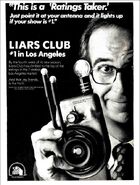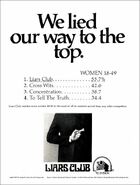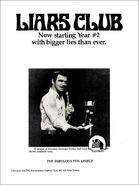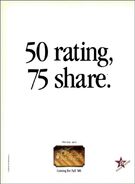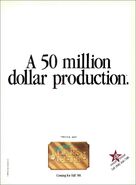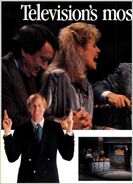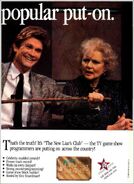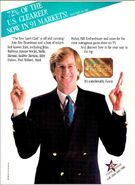(→Trivia) Tag: sourceedit |
(Adding categories) |
||
| (29 intermediate revisions by 9 users not shown) | |||
| Line 1: | Line 1: | ||
| − | {| |
+ | {| width="256" align="right" style="font-family: verdana, sans-serif; padding: 6px; margin: 0 0 1em 1em; font-size: 10px; background-color: #f7f8ff; border:1px solid #8888aa;" border="1" cellspacing="2" cellpadding="2" |
| align="center" colspan="2" |'''Hosts''' |
| align="center" colspan="2" |'''Hosts''' |
||
|- |
|- |
||
| ⚫ | |||
| − | | |
||
| ⚫ | |||
|- |
|- |
||
| align="center" colspan="2" |'''Announcers''' |
| align="center" colspan="2" |'''Announcers''' |
||
|- |
|- |
||
| ⚫ | |||
| − | | |
||
| ⚫ | |||
|- |
|- |
||
| − | | align="center" colspan="2" |'''Broadcast |
+ | | align="center" colspan="2" |'''Broadcast''' |
|- |
|- |
||
| − | |[[ |
+ | |[[File:Image123.png|center|160px]]Syndication (Daily): 1/20/1969 – 7/18/1969 |
| − | [[ |
+ | [[File:Liarsclub70s.jpg|center|160px]]KTLA (Weekly): 9/7/1974 – 12/20/1975<br />Syndication (Daily): 8/16/1976 – 9/1979 |
| − | [[ |
+ | [[File:Thenewliarsclub.jpg|center|160px]]Pilot: 11/9/1987<br />Syndication (Daily): 10/3/1988 – 6/30/1989 |
|- |
|- |
||
| align="center" colspan="2" |'''Packagers''' |
| align="center" colspan="2" |'''Packagers''' |
||
|- |
|- |
||
| − | |Ralph Andrews Productions ( |
+ | |Ralph Andrews Productions (1969–1979)<br />Four Star Productions<br />Golden West Productions<br />Northstar Productions (1988–1989) |
|- |
|- |
||
| style="text-align: center;"|'''Distributors''' |
| style="text-align: center;"|'''Distributors''' |
||
|- |
|- |
||
| − | |20th Century Fox Television ( |
+ | |20th Century Fox Television (1976–1978)<br />Sandy Frank Entertainment (1978–1979)<br />Four Star (1988–1989) |
|} |
|} |
||
| − | '''''Liar's Club''''' ( |
+ | '''''Liar's Club''''' (aka ''The New Liar's Club'') was a game show where a celebrity panel analyzed weird and unusual objects. |
==Gameplay== |
==Gameplay== |
||
| − | The show featured a panel of celebrity guests, who would be presented with an unusual object; each would give a ridiculous explanation of what the object was used for. Contestants (there were two on the 1969 version, four on the |
+ | The show featured a panel of celebrity guests, who would be presented with an unusual object; each would give a ridiculous explanation of what the object was used for. Contestants (there were two on the 1969 version, four on the 1980s version and the first season of the 1970s version, and three during the Ludden era) would guess which star was telling the true story. Starting with the 1970s version, the contestants placed bets on the star they thought told the truth. They played for money in the 1970s version; however, they played for points in the 1980s version. They started at 100 dollars/points ($200 for a short time in 1976) at the beginning of the game and were allowed to bet in $10 increments up to $100 during the first season of the 1970s version, and half of their earnings during the Ludden era, and the 1980s version's betting range was 10 to 50 points. |
===The Odds=== |
===The Odds=== |
||
| − | The odds |
+ | The odds increased for each round: |
| − | Round 1 |
+ | *'''Round 1''' – 1:1 |
| − | Round 2 |
+ | *'''Round 2''' – 2:1 |
| − | Round 3 |
+ | *'''Round 3''' – 5:1 |
| − | Round 4 |
+ | *'''Round 4''' – 10:1 |
| − | For part of the Bill Armstrong season, the odds were 2 |
+ | For part of the Bill Armstrong season, the odds were 2:1, 5:1, 10:1, and 20:1, and each contestant would be paid out at different odds in each round (one contestant would have 2:1 in the first round, one 5:1, one 10:1, and one 20:1, and then the odds would change for the contestants in each round thereafter), and contestants could bet up to $50 and the player with 2-1 odds chose any one celebrity and each of the other contestants chose one of the remaining celebrities. At one point in the series, if a contestant was the only one to pick the right celebrity in a round, his/her payout was doubled. |
===The Liar's Club Gallery/The Art Corner=== |
===The Liar's Club Gallery/The Art Corner=== |
||
| − | This was always the last round of the game in which artwork was presented before the panel and contestants. Each celebrity would each offer their own title for the art. Each |
+ | This was always the last round of the game in which artwork was presented before the panel and contestants. Each celebrity would each offer their own title for the art. Each contestant would then make one last wager on which star gave the right title. Correct answers from the contestants paid off the wager at a 10-1 payoff. |
===Ludden-era Final Round=== |
===Ludden-era Final Round=== |
||
| Line 46: | Line 44: | ||
---- |
---- |
||
| − | On the 1969 version, the |
+ | On the 1969 version, the contestant who chose the most correct panelists won $100. In the two more-remembered later versions, the contestant with the highest score won the game and a bonus prize (during the Ludden era of the 1970s version and the 1980s revival, a correct bet in all four rounds was also worth an additional prize). If there was a tie, the contestant who bet the most in the final round was the winner. If there was still a tie, the contestant who got the most right throughout the game was the winner. If there was still still a tie, whoever came closest to their pregame score selection without going over was the winner. |
==Music== |
==Music== |
||
| + | 1969 – Unknown<br /> |
||
| ⚫ | |||
| + | 1974 – "Mad Square Rock" by Jack Shaindlin<br /> |
||
| ⚫ | |||
| − | Vacation Prize Cue |
+ | Vacation Prize Cue – "Classey" (Formerly used on ''[[Give-N-Take]]'' as a prize cue)<br /> |
| − | Prize Cue |
+ | Prize Cue – "Red Arrow" (Also used on ''[[Give-N-Take]] ''and [[Temptation (2)|Temptation '81)]] for the main)<br /> |
| − | Prize Cue |
+ | Prize Cue – "Baby 'G" (Formerly used on ''[[Give-N-Take]]'' as the win cue)<br /> |
| − | Prize Cue |
+ | Prize Cue – "Benny"<br /> |
| − | Prize Cue |
+ | Prize Cue – "Circus Fun"<br /> |
| − | 1988 |
+ | 1988 – Gary Peterson |
==Inventor== |
==Inventor== |
||
Ralph Andrews |
Ralph Andrews |
||
| + | |||
| + | ==Taping Locations== |
||
| + | Los Angeles, CA (1969–1979)<br /> |
||
| + | Vancouver, BC (1988–1989) |
||
==Similar Shows== |
==Similar Shows== |
||
| − | [[All Star Secrets]] |
+ | ''[[All Star Secrets]]'' – Similar show but with unusual facts about the stars; aired on NBC in 1979<br /> |
| − | [[Balderdash]] |
+ | ''[[Balderdash]]'' – Similar show which aired on PAX in 2004–2005 |
==Gallery== |
==Gallery== |
||
| Line 72: | Line 76: | ||
081451812913201.jpg |
081451812913201.jpg |
||
</gallery> |
</gallery> |
||
| + | |||
| ⚫ | |||
| + | ===Tickets=== |
||
| ⚫ | |||
| + | The Liars' Club (March 16, 1969).jpg |
||
526719_622894584391989_1491103079_n.jpg |
526719_622894584391989_1491103079_n.jpg |
||
| ⚫ | |||
482851_622894617725319_10092585_n.jpg |
482851_622894617725319_10092585_n.jpg |
||
| ⚫ | |||
</gallery> |
</gallery> |
||
| + | |||
| + | ===Trade Ads=== |
||
<gallery position="center"> |
<gallery position="center"> |
||
Liar's_Club_1976.jpg |
Liar's_Club_1976.jpg |
||
| Line 82: | Line 91: | ||
LC_1977-2-14.jpg |
LC_1977-2-14.jpg |
||
</gallery> |
</gallery> |
||
| − | <gallery position="center"> |
+ | <gallery position="center" columns="3"> |
TNLC_50-75.jpg |
TNLC_50-75.jpg |
||
TNLC_50_Million_Dollar_Production.jpg |
TNLC_50_Million_Dollar_Production.jpg |
||
| Line 92: | Line 101: | ||
==Trivia== |
==Trivia== |
||
| − | + | Celebrity attorney/actress/producer Vicki Roberts was a regular researcher on the show, who brought in many of the strange objects that were used by scouring local antique shops in the Los Angeles area. |
|
| + | |||
| − | + | The 1988 version also aired simultaneously in [http://canadiangameshows.wikia.com/wiki/The_New_Liar's_Club Canada] as well. |
|
| ⚫ | |||
| + | |||
| ⚫ | |||
| ⚫ | In 1991, a Canadian game show called ''[http://canadiangameshows.wikia.com/wiki/The_Next_Line The Next Line]'', hosted by Kevin Frank, was produced. It had many similarities to the ''New Liar's Club'': both shows were taped at the same studio, and both used the same props with a few changes. The rules were very similar to ''Liar's Club'' in terms of the game and scoring, only rather than determine the correct description of an unusual item, players had to find which celebrity was giving the correct line to a cut-off video clip or song. Like ''The New Liar's Club'', the show was produced by Blair Murdoch and featured Pete Barbutti as a regular panelist. |
||
| + | |||
| ⚫ | |||
| + | |||
| + | The title is a spin on the Friars Club. |
||
==Links== |
==Links== |
||
| − | [http://loogaroo.startlogic.com/gameshow/rules/liarsclub.shtml Rules for the old Liar's Club]<br /> |
+ | [http://web.archive.org/web/20120423034311/http://loogaroo.startlogic.com/gameshow/rules/liarsclub.shtml Rules for the old ''Liar's Club'']<br /> |
| − | [http://replay.waybackmachine.org/20090319121426/http://www.xanfan.com/othergrabs/lc.htm Screengrabs of The New Liar's Club] |
+ | [http://replay.waybackmachine.org/20090319121426/http://www.xanfan.com/othergrabs/lc.htm Screengrabs of ''The New Liar's Club''] |
[[Category:Celebrity]] |
[[Category:Celebrity]] |
||
[[Category:Panel Game]] |
[[Category:Panel Game]] |
||
| + | [[Category:Gambling]] |
||
[[Category:Lying]] |
[[Category:Lying]] |
||
| + | [[Category:Regional]] |
||
| + | [[Category:California]] |
||
| + | [[Category:Syndicated shows]] |
||
[[Category:Ralph Andrews Productions]] |
[[Category:Ralph Andrews Productions]] |
||
[[Category:20th Century Fox Television]] |
[[Category:20th Century Fox Television]] |
||
| − | [[Category: |
+ | [[Category:Disney/ABC Television]] |
[[Category:Long-Running]] |
[[Category:Long-Running]] |
||
[[Category:Revivals]] |
[[Category:Revivals]] |
||
| + | [[Category:30 Minute Game Shows]] |
||
[[Category:1969 premieres]] |
[[Category:1969 premieres]] |
||
[[Category:1969 endings]] |
[[Category:1969 endings]] |
||
| + | [[Category:1974 premieres]] |
||
| + | [[Category:1975 endings]] |
||
[[Category:1976 premieres]] |
[[Category:1976 premieres]] |
||
[[Category:1979 endings]] |
[[Category:1979 endings]] |
||
[[Category:1988 premieres]] |
[[Category:1988 premieres]] |
||
[[Category:1989 endings]] |
[[Category:1989 endings]] |
||
| + | [[Category:Primetime shows]] |
||
Revision as of 20:21, 26 January 2020
| Hosts | |
| Rod Serling (1969) Bill Armstrong (1974–1977) Allen Ludden (1977–1979) Eric Boardman (1987–1989) | |
| Announcers | |
| Jim Isacs (1969) Bill Berry (1974–1975, 1977–1979) Joe Seiter (1976–1977) Bill Armstrong (1988–1989) Ted Friend (1988–1989) | |
| Broadcast | |
| Syndication (Daily): 1/20/1969 – 7/18/1969
KTLA (Weekly): 9/7/1974 – 12/20/1975 Syndication (Daily): 8/16/1976 – 9/1979 Pilot: 11/9/1987 Syndication (Daily): 10/3/1988 – 6/30/1989 | |
| Packagers | |
| Ralph Andrews Productions (1969–1979) Four Star Productions Golden West Productions Northstar Productions (1988–1989) | |
| Distributors | |
| 20th Century Fox Television (1976–1978) Sandy Frank Entertainment (1978–1979) Four Star (1988–1989) | |
Liar's Club (aka The New Liar's Club) was a game show where a celebrity panel analyzed weird and unusual objects.
Gameplay
The show featured a panel of celebrity guests, who would be presented with an unusual object; each would give a ridiculous explanation of what the object was used for. Contestants (there were two on the 1969 version, four on the 1980s version and the first season of the 1970s version, and three during the Ludden era) would guess which star was telling the true story. Starting with the 1970s version, the contestants placed bets on the star they thought told the truth. They played for money in the 1970s version; however, they played for points in the 1980s version. They started at 100 dollars/points ($200 for a short time in 1976) at the beginning of the game and were allowed to bet in $10 increments up to $100 during the first season of the 1970s version, and half of their earnings during the Ludden era, and the 1980s version's betting range was 10 to 50 points.
The Odds
The odds increased for each round:
- Round 1 – 1:1
- Round 2 – 2:1
- Round 3 – 5:1
- Round 4 – 10:1
For part of the Bill Armstrong season, the odds were 2:1, 5:1, 10:1, and 20:1, and each contestant would be paid out at different odds in each round (one contestant would have 2:1 in the first round, one 5:1, one 10:1, and one 20:1, and then the odds would change for the contestants in each round thereafter), and contestants could bet up to $50 and the player with 2-1 odds chose any one celebrity and each of the other contestants chose one of the remaining celebrities. At one point in the series, if a contestant was the only one to pick the right celebrity in a round, his/her payout was doubled.
The Liar's Club Gallery/The Art Corner
This was always the last round of the game in which artwork was presented before the panel and contestants. Each celebrity would each offer their own title for the art. Each contestant would then make one last wager on which star gave the right title. Correct answers from the contestants paid off the wager at a 10-1 payoff.
Ludden-era Final Round
During Ludden's first season, the final round consisted of each celebrity describing his/her own unusual item; during Ludden's second season, this round became the "Liar of the Day Round" and in a departure from the first three rounds, it was now up to the contestants to predict which celebrity was the liar.
On the 1969 version, the contestant who chose the most correct panelists won $100. In the two more-remembered later versions, the contestant with the highest score won the game and a bonus prize (during the Ludden era of the 1970s version and the 1980s revival, a correct bet in all four rounds was also worth an additional prize). If there was a tie, the contestant who bet the most in the final round was the winner. If there was still a tie, the contestant who got the most right throughout the game was the winner. If there was still still a tie, whoever came closest to their pregame score selection without going over was the winner.
Music
1969 – Unknown
1974 – "Mad Square Rock" by Jack Shaindlin
1976 – Stan Worth
Vacation Prize Cue – "Classey" (Formerly used on Give-N-Take as a prize cue)
Prize Cue – "Red Arrow" (Also used on Give-N-Take and Temptation '81) for the main)
Prize Cue – "Baby 'G" (Formerly used on Give-N-Take as the win cue)
Prize Cue – "Benny"
Prize Cue – "Circus Fun"
1988 – Gary Peterson
Inventor
Ralph Andrews
Taping Locations
Los Angeles, CA (1969–1979)
Vancouver, BC (1988–1989)
Similar Shows
All Star Secrets – Similar show but with unusual facts about the stars; aired on NBC in 1979
Balderdash – Similar show which aired on PAX in 2004–2005
Gallery
Tickets
Trade Ads
Trivia
Celebrity attorney/actress/producer Vicki Roberts was a regular researcher on the show, who brought in many of the strange objects that were used by scouring local antique shops in the Los Angeles area.
The 1988 version also aired simultaneously in Canada as well.
In 1991, a Canadian game show called The Next Line, hosted by Kevin Frank, was produced. It had many similarities to the New Liar's Club: both shows were taped at the same studio, and both used the same props with a few changes. The rules were very similar to Liar's Club in terms of the game and scoring, only rather than determine the correct description of an unusual item, players had to find which celebrity was giving the correct line to a cut-off video clip or song. Like The New Liar's Club, the show was produced by Blair Murdoch and featured Pete Barbutti as a regular panelist.
A pilot for a new version in 1996 was done with Ed McMahon hosting, but the series did not sell.
The title is a spin on the Friars Club.
Links
Rules for the old Liar's Club
Screengrabs of The New Liar's Club










